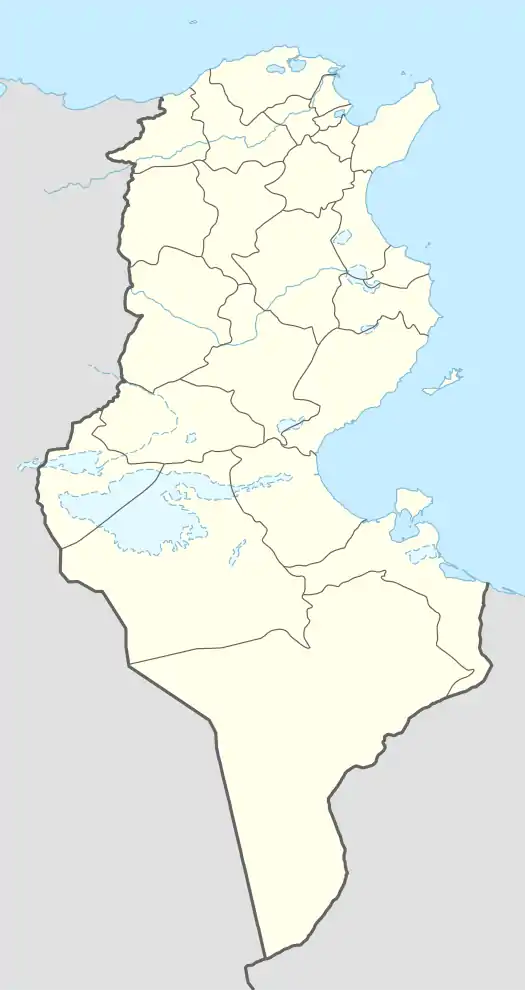Dahmani
(الدهماني) | |
|---|---|
Commune and town | |
| Nickname: Abbah Quşūr | |
 Dahmani Location in Tunisia | |
| Coordinates: 35°56′41″N 8°49′57″E / 35.94472°N 8.83250°E | |
| Country | |
| Governorate | Kef Governorate |
| Government | |
| • Mayor | Tarak Sahli (Nidaa Tounes) |
| Population (2014) | |
| • Total | 27 907 |
| [1] | |
| Time zone | UTC+1 (CET) |
Dahmani, formerly Abbah Quşūr (alternative spellings Abbah Qusur or Ebba Ksour), is a town and commune in the Kef Governorate, Tunisia.[2] As of 2004 it had a population of 14,061.[3] It is located at 625 meters above sea level, 225 kilometers southwest of Tunis.
History
Near the village known today as Medeina, 9 km to the southwest, is the archaeological site of Althiburos an ancient numidian city, and former Roman town hall.[2]
From 1941 on, it became a parish of the Roman Catholic Archdiocese of Tunis. In 1943 it accommodated the American troops engaged in the combat on the African front during World War II. Ebba-Ksour is the old name of the region where Dahmani is located. The name "Ebba" is believed to be derived from the Berber word for "water source" or "spring," while "Ksour" means "villages" or "fortified towns." Therefore, Ebba-Ksour roughly translates to "water source villages" or "spring fortified towns." The town of Dahmani has been inhabited for thousands of years and has a rich history that spans many civilizations. It was an important center of olive oil production during the Roman period, and some ruins of Roman villas and baths can still be seen in the surrounding countryside. During the Arab conquest of North Africa in the 7th century, Dahmani was one of the first towns in the region to embrace Islam. The town played a significant role in spreading the religion, and many scholars and Sufi masters lived in Dahmani during this period. In the 14th century, the town was ruled by the Hafsids, a Berber dynasty that controlled much of North Africa. They built several mosques and madrasas (Islamic schools) in Dahmani, including the Al Atiq Mosque, which still stands today. During the Ottoman period, which began in the 16th century, Dahmani became a center of agriculture and trade. The Ottomans built a fort in the nearby town of El Kef, which helped to secure the region and promote commerce. Dahmani also benefited from this period of stability, and many of its inhabitants became wealthy merchants. In the 19th century, Tunisia came under French colonial rule, and Dahmani was incorporated into the new administrative region of El Kef. The French built several public buildings in the town, including a post office and a school, which helped to modernize the area. After Tunisia gained independence in 1956, Dahmani remained a small rural town, with a predominantly agricultural economy. However, in recent years, the town has begun to develop its tourism industry, and many visitors now come to explore its natural beauty and cultural heritage.
Economy
Its main activity is agriculture, and in particular the production of wheat: it houses the largest wheat silos in central Tunisia. Dahmani is also known for its other resources:
Sport
The Dahmani Athletic Club, founded in 1932, is a football club based in Dahmani, Tunisia2 . The club's colors are yellow and black . The club has participated in the Coupe de Tunisie since the 2017-2018 season, with its best result obtained in 2017-2018, when it reached the second round.
Politics
Dahmani has a mayor. Recent mayors include:
- 1970-1975: Abderrahim Zouari
- 1980-2010: Hamadi Tebai
- 2013-present: Mohamed Hédi Ben Madhi[4]
Landmarks

- The church of Ebba Ksour,[5] located in the city of Dahmani (formerly Ebba Ksour), is a Catholic church built during the French protectorate. Ceded to the Tunisian government in 1964, it is now a dwelling house.
- The Dahmani meteorite is a 18kg meteorite that fell in May 1981 in Tunisia.[6] It was observed by villagers in the Dahmani region (Kef governorate) and recovered by French soldiers who went to the site and then handed over to the geological service of Tunis. The meteorite is listed by the Laboratory of Mineralogy-Crystallography, associated with the CNRS in Paris, the Laboratory of Mineralogy of the National Museum of Natural History of Paris and the famous Meteoritical Society.
Notable people
- Slama Kasdaoui, Tunisian footballer
- Fethia Khaïri, Tunisian actress
- Aymen Soltani, Tunisian footballer
- Abderrahim Zouari, Tunisian politician
- Fawzia Zouari, Tounisian journalist
References
- ↑ "Resultats". Archived from the original on 2014-10-29. Retrieved 2014-11-26.
- 1 2 Jacobs, Daniel; Morris, Peter (2001). The Rough Guide to Tunisia. Rough Guides. p. 286. ISBN 9781858287485. Retrieved 6 August 2017.
- ↑ (in French) Recensement de 2004 (Institut national de la statistique) Archived 2015-11-28 at the Wayback Machine
- ↑ Decree of 22 January 2013 dissolving the Dahmani Municipal Council of Kef Governorate and designating a special delegation, Official Gazette of the Republic of Tunisia, No. 9, January 29, 2013, pp. 447-448.
- ↑ church of Ebba Ksour
- ↑ "Meteoritical Bulletin: Entry for Dahmani". Lpi.usra.edu. 2017-08-19. Retrieved 2017-08-31.